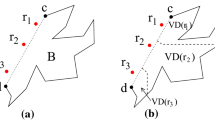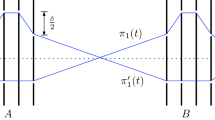Abstract
We present an algorithm for computingL 1 shortest paths among polygonal obstacles in the plane. Our algorithm employs the “continuous Dijkstra” technique of propagating a “wavefront” and runs in timeO(E logn) and spaceO(E), wheren is the number of vertices of the obstacles andE is the number of “events.” By using bounds on the density of certain sparse binary matrices, we show thatE =O(n logn), implying that our algorithm is nearly optimal. We conjecture thatE =O(n), which would imply our algorithm to be optimal. Previous bounds for our problem were quadratic in time and space.
Our algorithm generalizes to the case of fixed orientation metrics, yielding anO(nɛ−1/2 log2 n) time andO(nɛ−1/2) space approximation algorithm for finding Euclidean shortest paths among obstacles. The algorithm further generalizes to the case of many sources, allowing us to compute anL 1 Voronoi diagram for source points that lie among a collection of polygonal obstacles.
Similar content being viewed by others
References
T. Asano, Rectilinear shortest paths in a rectilinear simple polygon,Trans. IECE of Japan,E69 (1985), 750–758.
T. Asano, T. Asano, L. Guibas, J. Hershberger, and H. Imai, Visibility of disjoint polygons,Algorithmica,1 (1986), 49–63.
D. Bienstock and E. Györi, An extremal problem on sparse 0–1 matrices,SIAM Journal on Discrete Mathematics,4 (1991), 17–27.
B. Bollobás,Extremal Graph Theory, Academic Press, New York, 1978.
B. Chazelle, A functional approach to data structures and its use in multidimensional searching,SIAM Journal on Computing,17 (1988). 427–462.
B. Chazelle, An algorithm for segment dragging and its implementation,Algorithmica,3 (1988), 205–221.
B. Chazelle, H. Edelsbrunner, L. Guibas, and M. Sharir, Lines in space—Combinatorics, algorithms and applications,Proc. 21st Annual ACM Symposium on Theory of Computing, 1989, pp. 382–393.
K. Clarkson, Approximation algorithms for shortest path motion planning,Proc. 19th Annual ACM Symposium on Theory of Computing, New York City, May 25–27, 1987, pp. 56–65.
K. Clarkson, S. Kapoor, and P. Vaidya, Rectilinear shortest paths through polygonal obstacles inO(n log2 n) time,Proc. Third Annual ACM Symposium on Computational Geometry; Waterloo, Ontario, 1987, pp. 251–257.
P. J. de Rezende, D. T. Lee, and Y. F. Wu, Rectilinear shortest paths with rectangular barriers,Proc. First Annual ACM Symposium on Computational Geometry, 1985, pp. 204–213.
E. W. Dijkstra, A note on two problems in connexion with graphs,Numerische Mathematik,1 (1959), 269–271.
H. Edelsbrunner, L. J. Guibas, and J. Stolfi, Optimal point location in a monotone subdivision,SIAM Journal on Computing,16 (1986), 317–340.
H. Edelsbrunner, M. H. Overmars, and R. Seidel, Some methods of computational geometry applied to computer graphics,Computer Vision, Graphics, and Image Processing,28 (1984), 92–108.
S. J. Fortune, A sweepline algorithm for Voronoi diagrams,Algorithmica,2 (1987), 153–174.
Z. Füredi and P. Hajnal, Davenport-Schinzel theory of matrices, Manuscript, Department of Mathematics, MIT, October, 1989.
S. Kapoor and S. N. Maheshwari, Efficient algorithms for Euclidean shortest path and visibility problems with polygonal obstacles,Proc. Fourth Annual ACM Symposium on Computational Geometry, Urbana-Champaign, IL, June 6–8, 1988, pp. 172–182.
D. G. Kirkpatrick, Optimal search in planar subdivisions,SIAM Journal of Computing,12 (1983), 28–35.
R. C. Larson and V. O. Li, Finding minimum rectilinear distance paths in the presence of barriers,Networks,11 (1981), 285–304.
D. T. Lee, Proximity and reachability in the plane, Ph.D. Thesis, Technical Report R-831, Dept. of Electrical Engineering, University of Illinois, November 1978.
D. T. Lee, T. H. Chen, and C. D. Yang, Shortest rectilinear paths among weighted obstacles,Proc. Sixth Annual ACM Symposium on Computational Geometry, 1990, pp. 301–310.
D. T. Lee and F. P. Preparata, Euclidean shortest paths in the presence of rectilinear boundaries,Networks,14 (1984), 393–410.
D. T. Lee and C. K. Wong, Voronoi diagrams inL 1-(L ∞) metrics with 2-dimensional storage applications,SIAM Journal of Computing,9(1) (1980), 200–211.
L. Lovász,Combinatorial Problems and Exercises, North-Holland, Amsterdam, 1979.
T. Lozano-Perez and M. A. Wesley, An algorithm for planning collision-free paths among polyhedral obstacles,Communications of the ACM,22 (1979), 560–570.
J. S. B. Mitchell, Planning shortest paths, Ph.D. Thesis, Department of Operations Research, Stanford University, August, 1986.
J. S. B. Mitchell, Shortest rectilinear paths among obstacles, Technical Report No. 739, School of Operations Research and Industrial Engineering, Cornell University, April, 1987.
J. S. B. Mitchell, A new algorithm for shortest paths among obstacles in the plane,Annals of Mathematics and Artificial Intelligence,3 (1991), 83–106.
J. S. B. Mitchell, D. M. Mount, and C. H. Papadimitriou, The discrete geodesic problem,SIAM Journal on Computing,16(4) (1987), 647–668.
J. S. B. Mitchell and C. H. Papadimitriou, The weighted region problem: Finding shortest paths through a weighted planar subdivision,Journal of the ACM,38(1) (1991), 18–73.
N. J. Nilsson,Principles of Artifical Intelligence, Tioga Publishing Co., Palo Alto, CA, 1980.
J. Pach and M. Sharir, On vertical visibility in arrangements of segments and the queue size in the Bentley-Ottman line sweeping algorithm,First Canadian Conference on Computational Geometry, Montreal, Quebec, August 21–25, 1989. To appear:SIAM Journal on Computing.
C. H. Papadimitriou, An algorithm for shortest-path motion in three dimensions,Information Processing Letters,20 (1985), 259–263.
F. P. Preparata, A new approach to planar point location,SIAM Journal on Computing,10 (1981), 473–482.
F. P. Preparata and M. I. Shamos,Computational Geometry, Springer-Verlag, New York, 1985.
J. H. Reif and J. A. Storer, Shortest paths in Euclidean space with polyhedral obstacles, Technical Report CS-85-121, Computer Science Department, Brandeis University, April, 1985.
E. Schmeichel, Private Communication, Department of Mathematics and Computer Science, San Jose State University, 1986.
R. Seidel, Constrained Delaunay triangulations and Voronoi diagrams with obstacles, Technical Report Rep. 260, Institute für Information Processing, Graz, pp. 178–191, June, 1988.
M. Sharir,Davenport-Schinzel Sequences and their Geometric Applications, NATO ASI Series, Vol. F40, Theoretical Foundations of Computer Graphics and CAD (R. A. Earnshaw, ed.), Springer-Verlag, Berlin, 1988, pp. 253–278.
M. Sharir, R. Cole, K. Kedem, D. Leven, R. Pollack, and S. Sifrony, Geometric applications of Davenport-Schinzel sequences,Proc. 27th Annual IEEE Symposium on Foundations of Computer Science, 1986, pp. 77–86.
M. Sharir and A. Schorr, On shortest paths in polyhedral spaces,SIAM Journal on Computing,15 (1) (1986), 193–215.
E. Welzl, Constructing the visibility graph forn line segments inO(n 2) time,Information Processing Letters,20 (1985), 167–171.
P. Widmayer, Network design issues in VLSI, Manuscript, Institut für Informatik, University Freiburg, Rheinstra\e 10-12, 7800 Freiburg, West Germany, 1989.
P. Widmayer, Y. F. Wu, and C. K. Wong, On some distance problems in fixed orientations,SIAM Journal on Computing,16 (4), (1987), 728–746.
Author information
Authors and Affiliations
Additional information
Communicated by Bernard Chazelle.
Partially supported by a grant from Hughes Research Laboratories, Malibu, California and by NSF Grant ECSE-8857642. Much of this work was done while the author was a Ph.D. student at Stanford University, under the support of a Howard Hughes Doctoral Fellowship, and an employee of Hughes Research Laboratories.
Rights and permissions
About this article
Cite this article
Mitchell, J.S.B. L 1 shortest paths among polygonal obstacles in the plane. Algorithmica 8, 55–88 (1992). https://doi.org/10.1007/BF01758836
Received:
Revised:
Issue Date:
DOI: https://doi.org/10.1007/BF01758836




